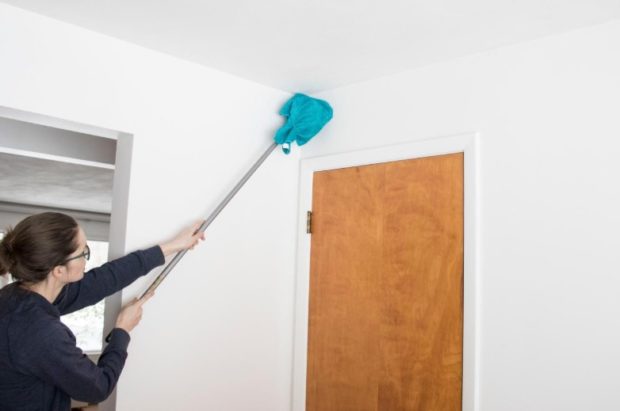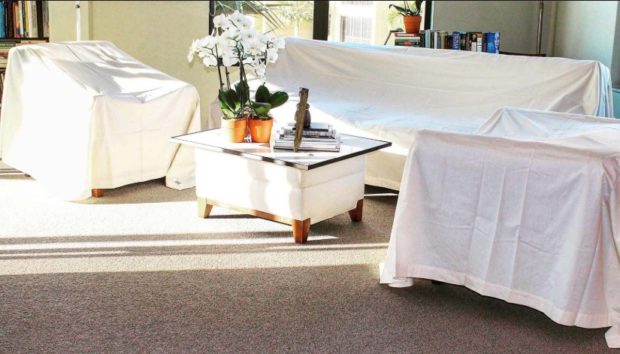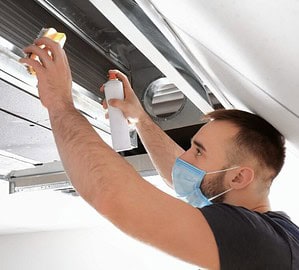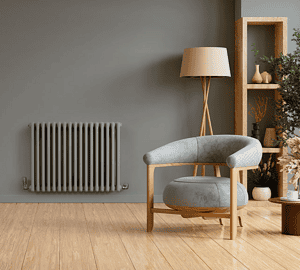It is impossible to avoid clouds of fine dust after having a drywall installation or repair job. It is true that the dust isn’t toxic, but it causes breathing problems so it would be wise to stop it from circulating.
Wetting it down might not be the way to go because it would turn into a soggy mess. You could try vacuuming, it seems like a good way to control it, but those tiny dust particles will surely clog the vacuum filter.

So, what do you do? Well, you will need to employ a combination of approaches to get rid of drywall dust effectively. In this article, we will go through the proper and effective process of cleaning drywall dust.
These are broken down into 3 stages, which are –
- Prepare The Area
- Control The Dust
- The Final Clean Up
Let’s look into each of the 3 stages one at a time.
1. Prepare The Area
Before you start cleaning, be sure to close off the vents and other openings in the room with plastic sheeting. This goes a long way in reducing the amount of dust that is released through the air.
Doorways and windows should be properly sealed off with plastic sheeting too. Hanging the sheeting from floor to ceiling will give you the best results.
You will also need to cover your floors and protect your furniture (especially upholstery). Move some furniture away from the area you want to clean, and if you can’t move it then make sure you cover them up with plastic sheeting. For efficiency, you should secure the plastic sheets in place with a cord.
Remember to turn off your central heat and air circulation. Leaving it on would result in drywall dust getting into it, which will eventually spread throughout your home. Make sure you leave it off until you’re done cleaning.
In the weeks to come, be sure to check your system’s air filter, there could be a need to replace it soon after. Also position the box fans so that air can be blown out of the room, and not inside it. You should also use plastic sheets to close up areas around fans and window frames.
One last tip for preparing the area before cleaning is to remove the door and window screens. You’d need to do this so that dust travels freely from inside to outside. Keep in mind that if you don’t remove the screens, a lot of dust will be trapped in the room, and you don’t want that.
2. Control The Dust
Dust is so pervasive so you would want to remove as much as you can before it piles up. Frequent cleaning throughout the project will help to reduce dust settlements around the area. Please be sure to wear a face mask while doing this to avoid inhaling the dust.
Another important thing to do is to limit the entry of people into the work area. The reason for this is that dry dust is very powdery so it’s easily stirred up just by people walking around it. Not only that, stirred up dust floats in the air for a while before it settles back down.
There is no question about it, you will need to keep people out. When I say people I mean those who are not part of the project going on inside.
You can control the work area by assigning just one entry, into and out of the room where the work is being done. Lock every other entrance and possibly put up a small sign to ward people off. The dust would be better controlled this way.
Another thing you can do is to place a foot may outside the door, just so people coming out can dust off their feet. This will reduce the spread of drywall dust to other areas of the building.

3. The Final Clean Up
Start by sweeping from outside the door and proceed to sweep down to the center of the room. You should not sweep aggressively so you don’t stir up more dust than you have to. Stroke gently!
As you like up the dust, use a dustpan to scoop them up and dump it in a trash bag. Be sure to tie up the trash bag immediately to keep the dust in. In a case where you are working with a significant amount of dusk, you can buy products that will help the dust stick to the floor.
You can get sweeping compounds to help you out. They are easy to use, just shake the compound over the areas you want to sweep and it will hold the dust down. Keep in mind that lots of these compounds need a full day to properly settle over the dust before you sweep. It is advised to read the instructions carefully before use.
When you’re done sweeping, you can proceed to vacuum the floors, a wet/dry vacuum is the most effective. You may not own one, not to worry, there are lots of home improvement stores that rent them out.
There are vacuum bags specially made for collecting drywall dust, make sure you use them.
The next step would be to wipe with a damp microfiber cloth. You will need to get a bucket and fill it up with water. Start wiping from the top of the walls and proceed downwards.
Every now and then, you will need to rinse out the cloth to rid it of dust. When you notice the water in the bucket has gotten cloudy, you will need to change it.
When you’re done with the walls, go over all horizontal surfaces in the room with the damp cloth. Outlet covers, baseboards, and light fixtures shouldn’t be left out.
Those are our tips, which you can use to clean up drywall dust. They are effective and they work every time. If you need more household guide, go to Home Dorks and find what you need.
We hope this article has been helpful.





